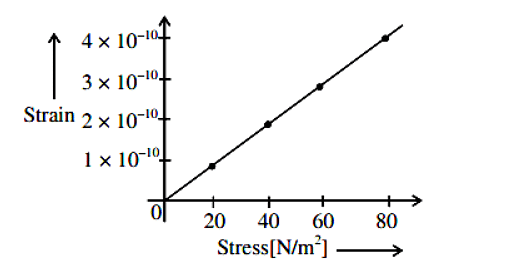Compute the bulk modulus of water from the following data: Initial volume = 100.0 litre, Pressure increase = 100.0 atm (1 atm = 1.013 × 105 Pa), Final volume = 100.5 litre. Compare the bulk modulus of water with that of air (at constant temperature). Explain in simple terms why the ratio is so large.
Solution and Explanation
Initial volume, V1 = 100.0l = 100.0 × 10 - 3 m3
Final volume, V2 = 100.5 l = 100.5 ×10 -3 m3
Increase in volume, ΔV = V2 - V1 = 0.5 × 10 - 3 m3
Increase in pressure, Δp = 100.0 atm = 100 × 1.013 × 10 5 Pa
Bulk modulus = \(\frac{Δp }{ ΔV / V_1} =\frac{ Δp × V_1 }{ ΔV} \)
\(= \frac{100 × 1.013 × 10 ^5 × 100 × 10 ^{- 3 }}{ 0.5 × 106^{ - 3 }}\)
= 2.026 × 10 9 Pa
Bulk modulus of air = 1.0 × 10 5 Pa
\(∴\frac{ \text{Bulk modulus of water }}{ \text{Bulk modulus of air} }\)
\(= \frac{2.026 × 10 ^9 }{ 1.0 × 10^ 5 }\)
= 2.026 × 10 4
This ratio is very high because air is more compressible than water.
Top Questions on elastic moduli
- The slope of the stress-strain curve in the elastic deformation region is
- JKCET - 2024
- Physics
- elastic moduli
- The law which states that within elastic limits strain produced is proportional to the stress producing it is known as
- JKCET - 2024
- Physics
- elastic moduli
- A wire of length L and radius r is clamped rigidly at one end. When the other end of the wire is pulled by a force F, its length increases by 5 cm. Another wire of the same material of length 4L and radius 4r is pulled by a force 4F under same conditions. The increase in length of this wire is ___ cm.
- JEE Main - 2022
- Physics
- elastic moduli
The elastic behavior of material for linear stress and linear strain, is shown in the figure. The energy density for a linear strain of 5×10–4 is ____ kJ/m3. Assume that material is elastic up to the linear strain of 5×10–4

- JEE Main - 2022
- Physics
- elastic moduli
- If the length of a wire is made double and radius is halved of its respective values. Then, the Young’s modulus of the material of the wire will :
- JEE Main - 2022
- Physics
- elastic moduli
Questions Asked in CBSE Class XI exam
- Arrange the bonds in order of increasing ionic character in the molecules: LiF, K2O, N2, SO2 and ClF3.
- CBSE Class XI
- Molecular Orbital Theory
- Three reasons why the author’s grandmother was disturbed when he started going to the city school.
- CBSE Class XI
- The Portrait of a lady
Two identical ball bearings in contact with each other and resting on a frictionless table are hit head-on by another ball bearing of the same mass moving initially with a speed V. If the collision is elastic, which of the following (Fig. 5.14) is a possible result after collision ?

- CBSE Class XI
- Collisions
- Why is it necessary to use acetic acid and not sulphuric acid for acidification of sodium extract for testing sulphur by lead acetate test?
- CBSE Class XI
- Organic Chemistry
- Prove that, cos 6 x = 32cos6 x-48cos4 x+18cos2 x -1.
- CBSE Class XI
- Trigonometric Functions of Sum and Difference of Two Angles